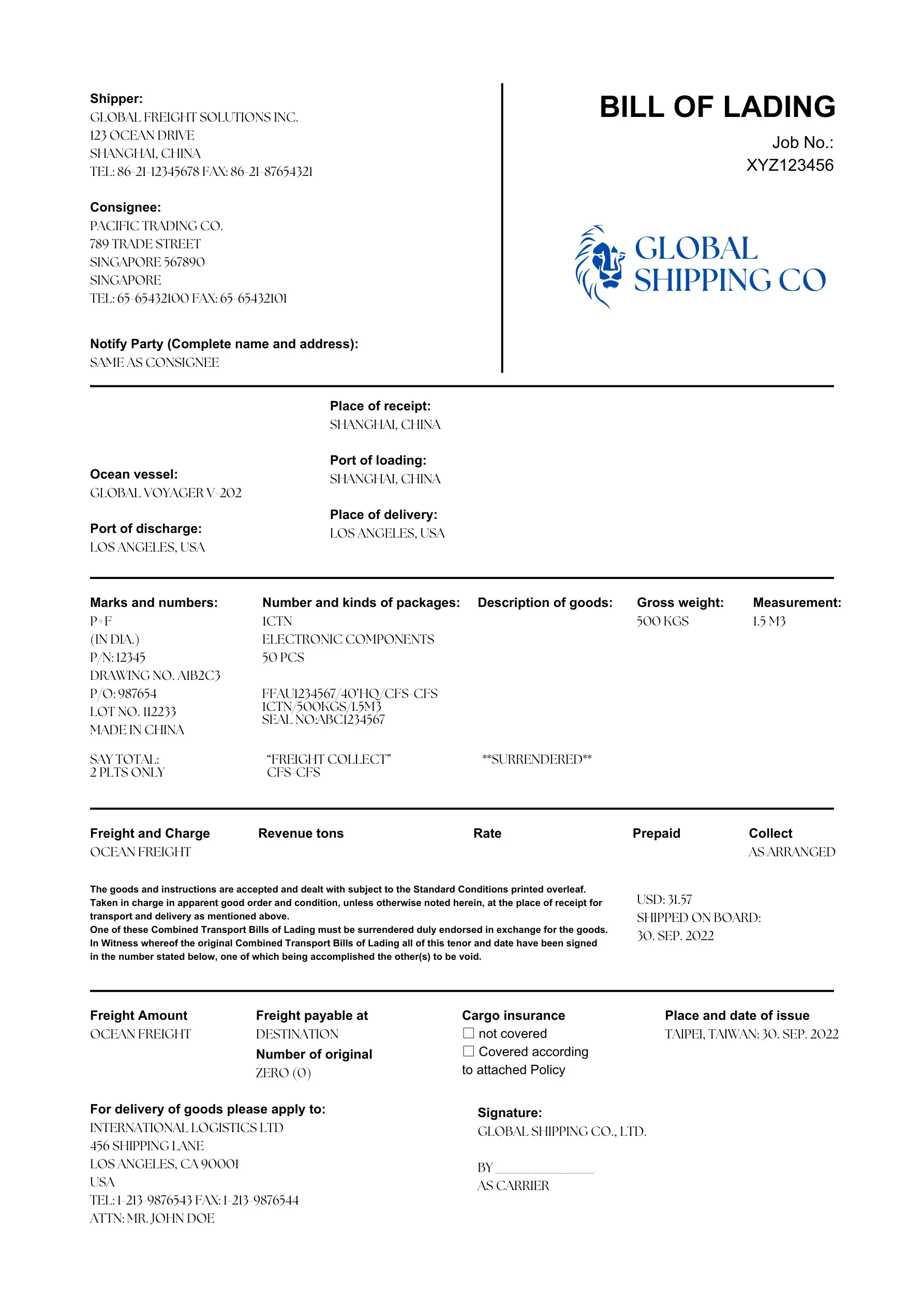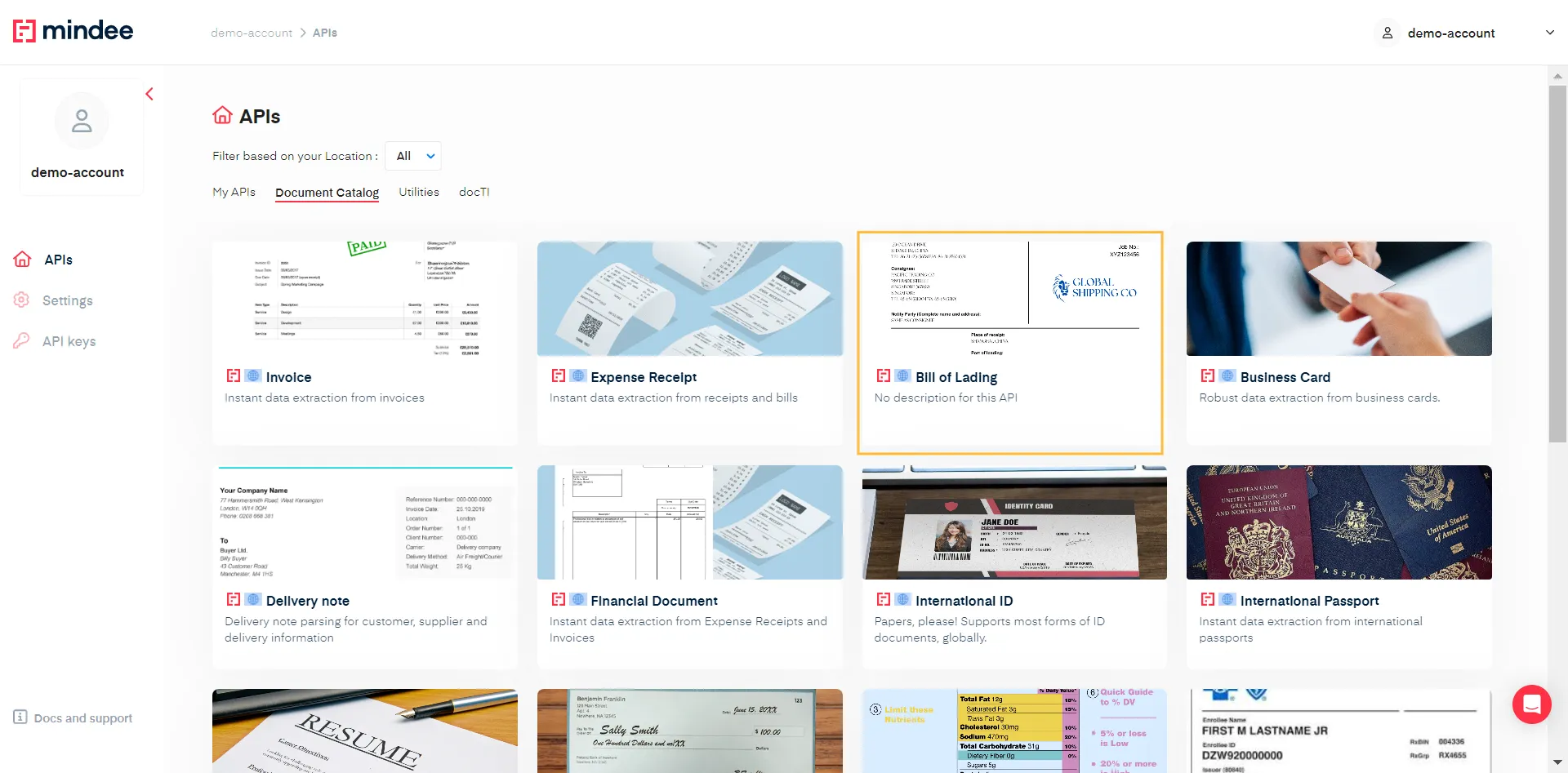Bill of Lading OCR
Automatically extract data from Bill of Lading documents
Mindee’s Bill Of Lading API uses deep learning to automatically, accurately, and instantaneously parse your documents details. In a few seconds, the API extracts a set of data from your PDFs or photos of Bill of Lading, including:
- Bill of Lading Number
- Shipper
- Consignee
- Notify Party
- Carrier
- Items
- Port of Loading
- Port of Discharge
- Place of Delivery
- Date of Issue
- Departure Date
Set up the API
Before making any API calls, you need to have created your API key.
- You'll need a Bill Of Lading. You can use one of the sample documents provided below.

- Access your Bill of Lading API by clicking on the corresponding product card in the Document Catalog

- From the left navigation, go to documentation > API Reference, you'll find sample code in popular languages and command line.
from mindee import Client, product, AsyncPredictResponse
# Init a new client
mindee_client = Client(api_key="my-api-key-here")
# Load a file from disk
input_doc = mindee_client.source_from_path("/path/to/the/file.ext")
# Load a file from disk and enqueue it.
result: AsyncPredictResponse = mindee_client.enqueue_and_parse(
product.BillOfLadingV1,
input_doc,
)
# Print a brief summary of the parsed data
print(result.document)
const mindee = require("mindee");
// for TS or modules:
// import * as mindee from "mindee";
// Init a new client
const mindeeClient = new mindee.Client({ apiKey: "my-api-key-here" });
// Load a file from disk
const inputSource = mindeeClient.docFromPath("/path/to/the/file.ext");
// Parse the file
const apiResponse = mindeeClient.enqueueAndParse(
mindee.product.BillOfLadingV1,
inputSource
);
// Handle the response Promise
apiResponse.then((resp) => {
// print a string summary
console.log(resp.document.toString());
});
using Mindee;
using Mindee.Input;
using Mindee.Product.BillOfLading;
string apiKey = "my-api-key-here";
string filePath = "/path/to/the/file.ext";
// Construct a new client
MindeeClient mindeeClient = new MindeeClient(apiKey);
// Load an input source as a path string
// Other input types can be used, as mentioned in the docs
var inputSource = new LocalInputSource(filePath);
// Call the product asynchronously with auto-polling
var response = await mindeeClient
.EnqueueAndParseAsync<BillOfLadingV1>(inputSource);
// Print a summary of all the predictions
System.Console.WriteLine(response.Document.ToString());
// Print only the document-level predictions
// System.Console.WriteLine(response.Document.Inference.Prediction.ToString());
#
# Install the Ruby client library by running:
# gem install mindee
#
require 'mindee'
# Init a new client
mindee_client = Mindee::Client.new(api_key: 'my-api-key')
# Load a file from disk
input_source = mindee_client.source_from_path('/path/to/the/file.ext')
# Parse the file
result = mindee_client.parse(
input_source,
Mindee::Product::BillOfLading::BillOfLadingV1
)
# Print a full summary of the parsed data in RST format
puts result.document
# Print the document-level parsed data
# puts result.document.inference.prediction
import com.mindee.MindeeClient;
import com.mindee.input.LocalInputSource;
import com.mindee.parsing.common.AsyncPredictResponse;
import com.mindee.product.billoflading.BillOfLadingV1;
import java.io.File;
import java.io.IOException;
public class SimpleMindeeClient {
public static void main(String[] args) throws IOException, InterruptedException {
String apiKey = "my-api-key-here";
String filePath = "/path/to/the/file.ext";
// Init a new client
MindeeClient mindeeClient = new MindeeClient(apiKey);
// Load a file from disk
LocalInputSource inputSource = new LocalInputSource(new File(filePath));
// Parse the file asynchronously
AsyncPredictResponse<BillOfLadingV1> response = mindeeClient.enqueueAndParse(
BillOfLadingV1.class,
inputSource
);
// Print a summary of the response
System.out.println(response.toString());
// Print a summary of the predictions
// System.out.println(response.getDocumentObj().toString());
// Print the document-level predictions
// System.out.println(response.getDocumentObj().getInference().getPrediction().toString());
// Print the page-level predictions
// response.getDocumentObj().getInference().getPages().forEach(
// page -> System.out.println(page.toString())
// );
}
}
API_KEY='my-api-key-here'
ACCOUNT='mindee'
ENDPOINT='bill_of_lading'
VERSION='1'
FILE_PATH='/path/to/your/file.png'
# Maximum amount of retries to get the result of a queue
MAX_RETRIES=10
# Delay between requests
DELAY=6
# Enqueue the document for async parsing
QUEUE_RESULT=$(curl -sS --request POST \
-H "Authorization: Token $API_KEY" \
-H "Content-Type: multipart/form-data" \
-F "document=@$FILE_PATH" \
"https://api.mindee.net/v1/products/$ACCOUNT/$ENDPOINT/v$VERSION/predict_async")
# Status code sent back from the server
STATUS_CODE=$(echo "$QUEUE_RESULT" | grep -oP "[\"|']status_code[\"|']:[\s][\"|']*[a-zA-Z0-9-]*" | rev | cut --complement -f2- -d" " | rev)
# Check that the document was properly queued
if [ -z "$STATUS_CODE" ] || [ "$STATUS_CODE" -gt 399 ] || [ "$STATUS_CODE" -lt 200 ]
then
if [ -z "$STATUS_CODE" ]
then
echo "Request couldn't be processed."
exit 1
fi
echo "Error $STATUS_CODE was returned by API during enqueuing. "
# Print the additional details, if there are any:
ERROR=$(echo "$QUEUE_RESULT" | grep -oP "[\"|']error[\"|']:[\s]\{[^\}]*" | rev | cut --complement -f2- -d"{" | rev)
if [ -z "$ERROR" ]
then
exit 1
fi
# Details on the potential error:
ERROR_CODE=$(echo "$ERROR" | grep -oP "[\"|']code[\"|']:[\s]\"[^(\"|\')]*" | rev | cut --complement -f2- -d"\"" | rev)
MESSAGE=$(echo "$QUEUE_RESULT" | grep -oP "[\"|']message[\"|']:[\s]\"[^(\"|\')]*" | rev | cut --complement -f2- -d"\"" | rev)
DETAILS=$(echo "$QUEUE_RESULT" | grep -oP "[\"|']details[\"|']:[\s]\"[^(\"|\')]*" | rev | cut --complement -f2- -d"\"" | rev)
echo "This was the given explanation:"
echo "-------------------------"
echo "Error Code: $ERROR_CODE"
echo "Message: $MESSAGE"
echo "Details: $DETAILS"
echo "-------------------------"
exit 1
else
echo "File sent, starting to retrieve from server..."
# Get the document's queue ID
QUEUE_ID=$(echo "$QUEUE_RESULT" | grep -oP "[\"|']id[\"|']:[\s][\"|'][a-zA-Z0-9-]*" | rev | cut --complement -f2- -d"\"" | rev)
# Amount of attempts to retrieve the parsed document were made
TIMES_TRIED=1
# Try to fetch the file until we get it, or until we hit the maximum amount of retries
while [ "$TIMES_TRIED" -lt "$MAX_RETRIES" ]
do
# Wait for a bit at each step
sleep $DELAY
# Note: we use -L here because the location of the file might be behind a redirection
PARSED_RESULT=$(curl -sS -L \
-H "Authorization: Token $API_KEY" \
"https://api.mindee.net/v1/products/$ACCOUNT/$ENDPOINT/v$VERSION/documents/queue/$QUEUE_ID")
# Isolating the job (queue) & the status to monitor the document
JOB=$(echo "$PARSED_RESULT" | grep -ioP "[\"|']job[\"|']:[\s]\{[^\}]*" | rev | cut --complement -f2- -d"{" | rev)
QUEUE_STATUS=$(echo "$JOB" | grep -ioP "[\"|']status[\"|']:[\s][\"|'][a-zA-Z0-9-]*" | rev | cut --complement -f2- -d"\"" | rev)
if [ "$QUEUE_STATUS" = "completed" ]
then
# Print the result
echo "$PARSED_RESULT"
# Optional: isolate the document:
# DOCUMENT=$(echo "$PARSED_RESULT" | grep -ioP "[\"|']document[\"|']:[\s].*([\"|']job[\"|'])" | rev | cut -f2- -d"," | rev)
# echo "{$DOCUMENT}"
# Remark: on compatible shells, fields can also be extracted through the use of tools like jq:
# DOCUMENT=$(echo "$PARSED_RESULT" | jq '.["document"]')
exit 0
fi
TIMES_TRIED=$((TIMES_TRIED+1))
done
fi
echo "Operation aborted, document not retrieved after $TIMES_TRIED tries"
exit 1
<?php
use Mindee\Client;
use Mindee\Product\BillOfLading\BillOfLadingV1;
// Init a new client
$mindeeClient = new Client("my-api-key-here");
// Load a file from disk
$inputSource = $mindeeClient->sourceFromPath("/path/to/the/file.ext");
// Parse the file asynchronously
$apiResponse = $mindeeClient->enqueueAndParse(BillOfLadingV1::class, $inputSource);
echo $apiResponse->document;
- Replace my-api-key-here with your new API key, or use the "select an API key" feature and it will be filled automatically.
- Copy and paste the sample code of your desired choice in your application, code environment or terminal.
- Replace
/path/to/my/filewith the path to your document.
Always remember to replace your API key!
- Run your code. You will receive a JSON response with the Bill of Lading details.
API Response
Here is the full JSON response you get when you call the API:
{
"api_request": {
"error": {},
"resources": [
"document",
"job"
],
"status": "success",
"status_code": 200,
"url": "https://api.mindee.net/v1/products/mindee/bill_of_lading/v1/documents/.."
},
"document": {
"id": "bae163d3-ea9c-4972-bd28-2a7598d3d424",
"inference": {
"extras": {},
"finished_at": "2024-10-17T15:01:28.197000",
"is_rotation_applied": true,
"pages": [
{
"extras": {},
"id": 0,
"orientation": {
"value": 0
},
"prediction": {}
}
],
"prediction": {..},
"processing_time": 7.42,
"product": {
"features": [
"bill_of_lading_number",
"shipper",
"consignee",
"notify_party",
"carrier",
"carrier_items",
"port_of_loading",
"port_of_discharge",
"place_of_delivery",
"date_of_issue",
"departure_date"
],
"name": "mindee/bill_of_lading",
"type": "standard",
"version": "1.1"
},
"started_at": "2024-10-17T15:01:20.640000"
},
"n_pages": 1,
"name": "Bill_of_lading_sample.jpg"
},
"job": {
"available_at": "2024-10-17T15:01:28.208000",
"error": {},
"id": "8ae70ce3-ef4f-44dc-af7c-738b54e44423",
"issued_at": "2024-10-17T15:01:20.640000",
"status": "completed"
}
}
You can find the prediction within the prediction key found in document > inference > prediction for document-level predictions: it contains the different fields extracted at the document level, meaning that for multi-pages PDFs, we reconstruct a single object using all the pages.
"document": {
...
"prediction": {
"bill_of_lading_number": {
"value": "XYZ123456"
},
"carrier": {
"name": "GLOBAL SHIPPING CO",
"professional_number": null,
"scac": null
},
"carrier_items": [
{
"description": "ELECTRONIC COMPONENTS\nP/N: 12345\nDRAWING NO. A1B2C3\nP/O: 987654\nLOT NO. 112233\nMADE IN CHINA",
"gross_weight": 500.0,
"measurement": 1.5,
"measurement_unit": "cbm",
"quantity": 50.0,
"weight_unit": "kgs"
}
],
"consignee": {
"address": "789 TRADE STREET, SINGAPORE 567890, SINGAPORE",
"email": null,
"name": "PACIFIC TRADING CO.",
"phone": "65-65432100"
},
"date_of_issue": {
"value": "2022-09-30"
},
"departure_date": {
"value": null
},
"notify_party": {
"address": "789 TRADE STREET, SINGAPORE 567890, SINGAPORE",
"email": null,
"name": "PACIFIC TRADING CO.",
"phone": "65-65432100"
},
"place_of_delivery": {
"value": "456 SHIPPING LANE, LOS ANGELES, CA 90001, USA"
},
"port_of_discharge": {
"value": "LOS ANGELES, USA"
},
"port_of_loading": {
"value": "SHANGHAI, CHINA"
},
"shipper": {
"address": "123 OCEAN DRIVE, SHANGHAI, CHINA",
"email": null,
"name": "GLOBAL FREIGHT SOLUTIONS INC.",
"phone": "86-21-12345678"
}
},
"processing_time": 7.42,
"product": {
"features": [
"bill_of_lading_number",
"shipper",
"consignee",
"notify_party",
"carrier",
"carrier_items",
"port_of_loading",
"port_of_discharge",
"place_of_delivery",
"date_of_issue",
"departure_date"
],
"name": "mindee/bill_of_lading",
"type": "standard",
"version": "1.1"
},
"started_at": "2024-10-17T15:01:20.640000"
},
"n_pages": 1,
"name": "Bill_of_lading_sample.jpg"
},
"job": {
"available_at": "2024-10-17T15:01:28.208000",
"error": {},
"id": "8ae70ce3-ef4f-44dc-af7c-738b54e44423",
"issued_at": "2024-10-17T15:01:20.640000",
"status": "completed"
}
}
Extracted data
Using the above Bill of Lading example the following are the basic fields that can be extracted.
- Bill of Lading Number
- Shipper
- Consignee
- Notify Party
- Carrier
- Items
- Port of Loading
- Port of Discharge
- Place of Delivery
- Date of Issue
- Departure Date
Bill of Lading Number
- bill_of_lading_number: Unique identifier assigned to a Bill of Lading.
{
"bill_of_lading_number": {
"value": "XYZ123456"
}
}
Shipper
- Shipper: The party responsible for shipping the goods.
- name: The name of the shipper.
- address: The address of the shipper.
- phone: the phone number of the shipper.
- email: the email address of the shipper.
{
"shipper": {
"address": "123 OCEAN DRIVE, SHANGHAI, CHINA",
"email": null,
"name": "GLOBAL FREIGHT SOLUTIONS INC.",
"phone": "86-21-12345678"
}
}
Consignee
- consignee: The party to whom the goods are being shipped.
- name: The name of the consignee.
- address: The address of the consignee.
- phone: the phone number of the consignee.
- email: the email address of the consignee.
{
"consignee": {
"address": "789 TRADE STREET, SINGAPORE 567890, SINGAPORE",
"email": null,
"name": "PACIFIC TRADING CO.",
"phone": "65-65432100"
}
}
Notify Party
- notify_party: The party to be notified of the arrivals of the goods.
- name: The name of the notify party.
- address: The address of the notify party.
- phone: the phone number of the notify party.
- email: the email address of the notify party.
{
"notify_party": {
"address": "789 TRADE STREET, SINGAPORE 567890, SINGAPORE",
"email": null,
"name": "PACIFIC TRADING CO.",
"phone": "65-65432100"
}
}
Carrier
- carrier: The shipping company responsible for the transport of the good.
- name: The name of the carrier.
- professional_number: The professional number of the carrier.
- scac: The Standard Carrier Alpha Code (SCAC) of the carrier.
{
"carrier": {
"name": "GLOBAL SHIPPING CO",
"professional_number": null,
"scac": null
}
}
Items
- carrier_items: The goods being shipped.
- description: A description of the item.
- quantity: The quantity of the item being shipped.
- gross_weight: The gross weight of the item.
- weight_unit: The unit of measurement for weights.
- measurement: The measurement of the item.
- measurement_unit: The unit of measurement for the measurement.
{
"carrier_items": [
{
"description": "ELECTRONIC COMPONENTS\nP/N: 12345\nDRAWING NO. A1B2C3\nP/O: 987654\nLOT NO. 112233\nMADE IN CHINA",
"gross_weight": 500,
"measurement": 1.5,
"measurement_unit": "cbm",
"quantity": 50,
"weight_unit": "kgs"
}
]
}
Port of loading
- port_of_loading: The port where the goods are loaded on the vessel.
{
"port_of_loading": {
"value": "SHANGHAI, CHINA"
}
}
Port of Discharge
- port_of_discharge: The port where the goods are unloaded on the vessel.
{
"port_of_discharge": {
"value": "LOS ANGELES, USA"
}
}
Place of Delivery
- place_of_delivery: The place where the goods are to be delivered.
{
"place_of_delivery": {
"value": "456 SHIPPING LANE, LOS ANGELES, CA 90001, USA"
}
}
Date of Issue
- date_of_issue: The date when the bill lading is issued.
{
"date_of_issue": {
"value": "2022-09-30"
}
}
Departure Date
- departure_date: The date when the vessel departs from the port of loading.
{
"departure_date": {
"value": null
}
}
Updated 7 months ago
